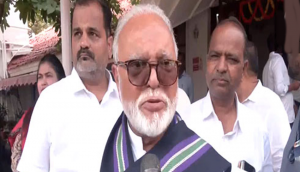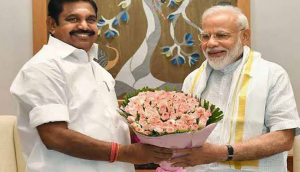Lose-lose situation: why Cong must avoid tie-up with Left in Bengal

The idea
- The Congress and the Left are contemplating a tie-up for the West Bengal polls
- The idea seems to have more traction among Left leaders, with ex-CM Buddhadeb appealing to Cong
The futility
- Data from the 2014 Lok Sabha polls suggests the Congress\'s main rival in the state is actually the Left Front
- Even if they ally together, it looks difficult for them to topple Mamata Banerjee\'s TMC
More in the story
- Are state Cong chief Adhir Ranjan Chowdhury and his colleagues on the same page?
- Could there be an implicit understanding between the Congress and the TMC?
The Congress and the Left Front seem to be mulling over the possibility of an alliance in the West Bengal Assembly elections.
Many leaders and supporters on both sides seem to be in favour of the alliance. Some are already speaking of going back to the good old days of UPA-1, in which the Left supported the Congress-led government from the outside.
The most open overture came from former West Bengal Chief Minister Buddhadeb Bhattacharjee, who appealed to the Congress to form an alliance to dislodge the Trinamool Congress.
Former CM Buddhadeb Bhattacharjee has appealed to the Congress to ally with the Left Front
"Which side are you on? In this battle, which side are you on?" Bhattacharjee asked the Congress last week, goading it towards an alliance.
What the numbers say
The push for an alliance began in April last year, after the Left Front wrested control of the Siliguri Municipal Corporation with the help of an informal understanding with the Congress. The two repeated the 'Siliguri Model' in the Siliguri Mahakuma Parishad polls in October. Here again, the Left emerged victorious.
Also read: Investors promise Bengal Rs 2.5 lakh crore. Is Mamata restoring lost glory?
However, despite Bhattacharjee's appeal, UPA-1 nostalgia and the Siliguri Model, the simple truth is that the Congress has very little to gain by aligning with the Left.
Data from the 2014 Lok Sabha elections reveals three interesting trends:
- Even if the Left Front and Congress come together, they are nowhere near defeating Mamata Banerjee
- The Congress's real rival in West Bengal isn't the TMC, but the Left Front
Only the Left Front stands to gain from an alliance with the Congress. Hence the desperation.
Even if the Left Front and Congress come together, they are nowhere near defeating Mamata Banerjee
Here's how the numbers stacked up in 2014:
- Total seats: 42
- TMC: 34 seats (Vote share: 39.30%)
Left Front: 2 seats (Vote share 22.70%)
- BJP: 2 seats (Vote share: 16.80%)
Congress: 4 seats (Vote share: 9.80%)
If one looks at the Assembly segments each party led in during the Lok Sabha elections, it is clear that the TMC is heading for a thumping majority.
- Total seats: 294
- TMC: 216
Left Front: 28
- BJP: 22
Congress: 28
Based on the 2014 elections, a Congress-Left alliance can turn the tables in 41 seats, if there is a near complete transfer of votes between the two. The numbers would look something like this:
- TMC: 181
- Left + Congress: 97
BJP: 16
Despite an alliance between the Congress and the Left Front, the TMC would still win a comfortable majority.
The TMC's supremacy was further established in the civic elections last year.
Then why are the Left Front and the Congress considering an alliance?
It seems that the desperation is more on the side of the Left Front rather than the Congress. This is understandable. Despite having a vote share of 22.60%, the Left led in only 28 Assembly segments. The Congress can offer a small chunk of votes in every seat that may prove valuable to the Left, as was the case in the civic elections in Siliguri.
For the Left, the alliance is important not just at the state level, but at the national level as well. It would help the Left end its isolation in national politics.
Left is the Congress's main rival
There's a peculiar trend related to the Congress in West Bengal. In 2014, it won more Lok Sabha seats than the Left and the BJP, even though it had a much smaller vote share.
The reason is that the Congress's votes are concentrated in a handful of districts like Uttar Dinajpur, Malda, Murshidabad and parts of Purulia.
Also read: #BengalElections: Mamata replaces Ma Maati Manush with Muslims
In the Lok Sabha polls, Congress was among the top 2 parties in only 44 Assembly segments. In a bulk of the remaining 250 seats, the Congress's vote share was less than 10%.
On 29 of the 44 seats in question, its main rival was the Left, while on 10 and 5 seats respectively, it was the TMC and the BJP.
In the 2009 Lok Sabha elections, the Congress won 6 seats: Raiganj, Maldaha Uttar, Maldaha Dakshin, Jangipur, Murshidabad and Baharampur. It lost two of these seats in 2014 - Raiganj and Murshidabad - both to the CPI(M).
These were the only two seats the Left Front ended up winning in the entire state.
In almost every Assembly segment in Raiganj, Maldaha Uttar, Jangipur and Murshidabad, the Congress was in direct competition with the Left Front.
By aligning with the Left, the Congress would be harming itself and providing space to its main rival in its own bastions.
Congress divided
Interestingly, the only Congress citadel where it faces a significant challenge from the TMC is Baharampur. This is the bastion of West Bengal Pradesh Congress Committee president Adhir Ranjan Chowdhury, 4-time MP from the seat.
Out of the 7 Assembly segments in Baharampur, the TMC was the Congress's main rival in 5 seats and the Left Front in 2.
It is perhaps no coincidence that Chowdhury is supposed to be in favour of an alliance with the Left.
Baharampur had been a Left bastion for decades. The Revolutionary Socialist Party held the seat from 1952 to 1998, with the only exception being the Congress wave of 1984.
Also read: 'Bengal has become a corridor of anti-national activity', says Adhir Ranjan Chowdhury
In 1999, Chowdhury successfully breached the fortress. At the time, he was one of the few leaders who was able to match the Left Front in terms of organisation and muscle power. He has held the seat since then.
However since 2012, the TMC has been gradually making inroads into his territory, and this was evident in the party's challenge to Chowdhury in the Lok Sabha elections.
While Chowdhury might be pushing for an alliance to defend his turf, other Congress leaders are opposing it for the same reasons.
For Mausam Noor and Abu Hasem Khan Chowdhury, MPs from Maldaha Uttar and Maldaha Dakshin respectively, the main fight is with the Left, and it would be difficult for them to justify an alliance to their supporters.
The same goes for former WBPCC president Manas Ranjan Bhunia. Bhunia is the MLA from Sabang in Pashchim Medinipur district. Like the Ghani Khan family of Malda, Bhunia's main rivalry has been with the Left Front ever since he first won the seat in 1982.
Deal or no deal?
Many Congress workers on the ground, who have been on the receiving end of attacks from TMC cadres, feel that an alliance with the Left is necessary. This is particularly true in South Bengal, where the TMC enjoys hegemonic power and the Congress's presence is marginal.
But besides this, there seems very little justification for the alliance from the Congress's side. On the contrary, if the Congress arrives at a secret understanding with the TMC, it could try and maximise its performance in the 44 seats in which it is a serious player.
Who knows, it might even emerge as the second largest party in the West Bengal Assembly.
Also read: Govt to set up 10,000 new LPG dealerships. Noble agenda or poll gimmick?
First published: 21 January 2016, 12:39 IST






![BJP's Kapil Mishra recreates Shankar Mahadevan’s ‘Breathless’ song to highlight Delhi pollution [WATCH] BJP's Kapil Mishra recreates Shankar Mahadevan’s ‘Breathless’ song to highlight Delhi pollution [WATCH]](https://images.catchnews.com/upload/2022/11/03/kapil-mishra_240884_300x172.png)

![Anupam Kher shares pictures of his toned body on 67th birthday [MUST SEE] Anupam Kher shares pictures of his toned body on 67th birthday [MUST SEE]](https://images.catchnews.com/upload/2022/03/07/Anupam_kher_231145_300x172.jpg)






